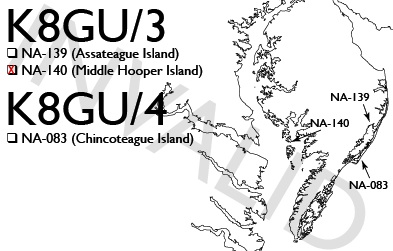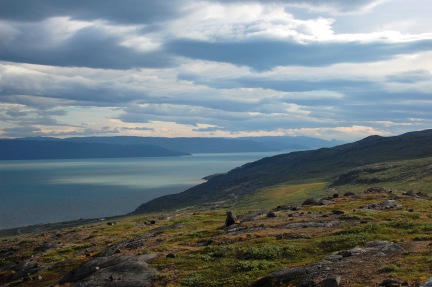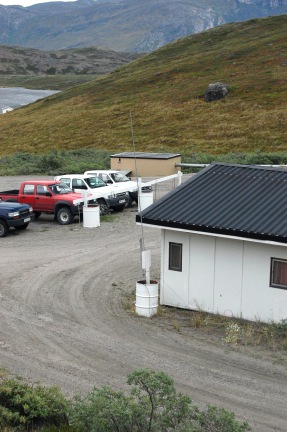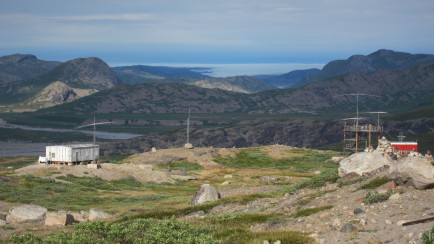
I forgot my camera at home and my mobile phone battery died so there are no photographs of this adventure…
I first experienced the passion of those pursuing RSGB’s Islands on the Air (IOTA) programm(e) when I was active from Adak (Andreanof Islands, NA-039) in August/September 2012. Matt, KB9UWU, and I made some tentative plans to do the 2013 RSGB IOTA Contest from NA-139 (Maryland State East, Assateague), returning to the site where he and W3CF had done the same contest over a decade prior. During the planning stage, I cast about for the nearest IOTA groups to activate. For the DC area, the easiest groups are surrounding the Delmarva Penninsula, NA-083 (Virgina State), NA-139 (Maryland State East) and NA-140 (Maryland State West). We did not execute the plan to go to NA-139 and I had really given up on the idea of doing anything for the IOTA contest…
That’s when work interviened. I scheduled a trip to Greenland (story about this to follow in a future posting) leaving late on Sunday of the IOTA contest weekend. My wife had a cousin with a baby shower in Ohio on Saturday…so, we did the logical thing…packed her and our son off to Ohio on a Saturday morning flight. After dropping them off at the airport, I headed to the Eastern Shore for some IOTA action.
The principal mission for this trip would be to understand the difficulties in activating NA-140 and to make it widely available to the IOTA community because it is apparently rather rare (25% claimed, versus 19% claimed for Adak).
The station setup was simple and typical—an Elecraft K3 and an updated version of the GU Special. The GU Special had just returned Tuesday from KL2HD’s KL7NWR expedition to NA-064 back in June (he had left it on the research ship until it returned to port, so technically, it’s probably visited some other rare IOTAs, too).
In order to avoid discharging the car’s battery, a mistake that could leave me stranded far from home, I lugged along a few SLA batteries to power everything. I selected a couple of candidate sites using aerial imagery and ended up using my preferred site, which was very accessible to saltwater and the road, making it trivial to setup the radio in the car and
the antenna on the beach. I now understand why NA-083 and NA-139 have much more activity—they’re close to civilization! Nevermind, I love the middle of nowhere. So, it was fun.
I configured the antenna for 20 meters and launched a few CQs on CW. It took a while to get a run established, but after that the pileup was pretty much non-stop for about 3 hours. I even worked some JAs, which was pleasing considering that NA-140 is very rare there and I was not QRV during the peak hours for JA.
Unfortunately, I hadn’t rigorously tested the batteries beforehand (except for one) and only one (the one I tested, of course) of the five performed well. One performed acceptably and was relegated to running the inverter for the laptop once the battery warning came on. Even the “good” battery sagged under load at 100w transmitter power. So, I cranked the K3 down to 50w and let it rip. That was enough to produce a commanding signal in Europe, with RBN Skimmers showing my signal peaking at 47 dB SNR with many hits in the 30s of dB. As Matt said when we talked after I returned home, “I have trouble getting those kind of numbers with a small beam and the legal limit!” Verticals on saltwater rule. End of story. Hearing was a different issue as there was some line noise and the occasional passing boat, who provided more QRM in the audio range than the RF range.
My pileup thinned out a little bit around 2020 UT and I was exhausted. Evan didn’t sleep well the night before and that didn’t help anybody else sleep, either. Plus, it was hot, even with the nice breeze and pleasant temperatures. If all of that wasn’t enough, the battery in my mobile phone had discharged, the battery in the laptop was nearly dead and both the K3 and the inverter began
throwing low-voltage alarms. It was time to pack up. Fortunately, the GU Special deploys and stows in 15-20 minutes, so it wasn’t bad.
I ended the three-hour window with 215 QSOs and 11 (!!! that’s what you get for CQing the whole time) island multipliers, all on 20 meters. I’ll take it! Thanks for the QSOs. I just ordered cards today and they should be printed and ready to send by mid-August.




